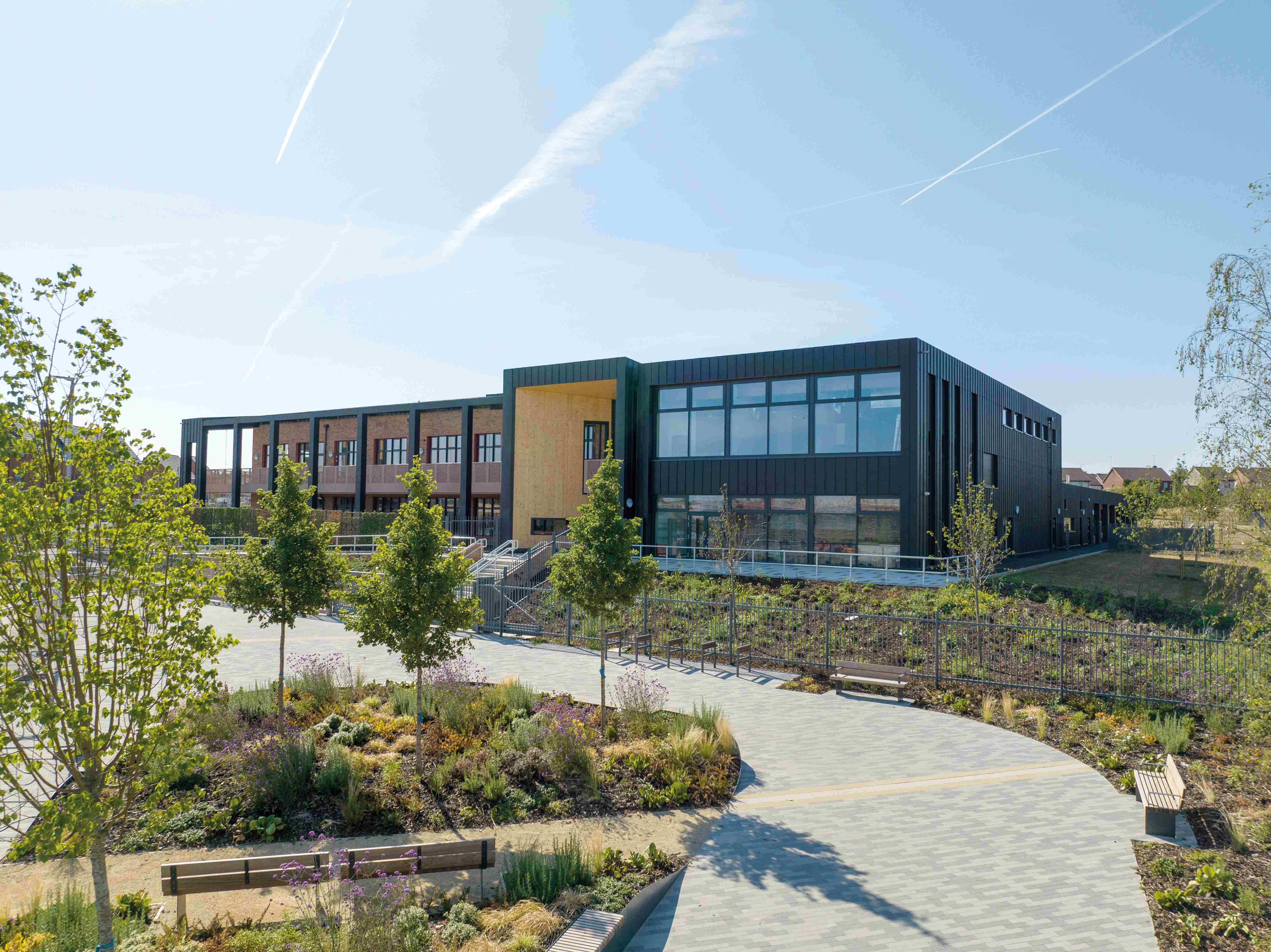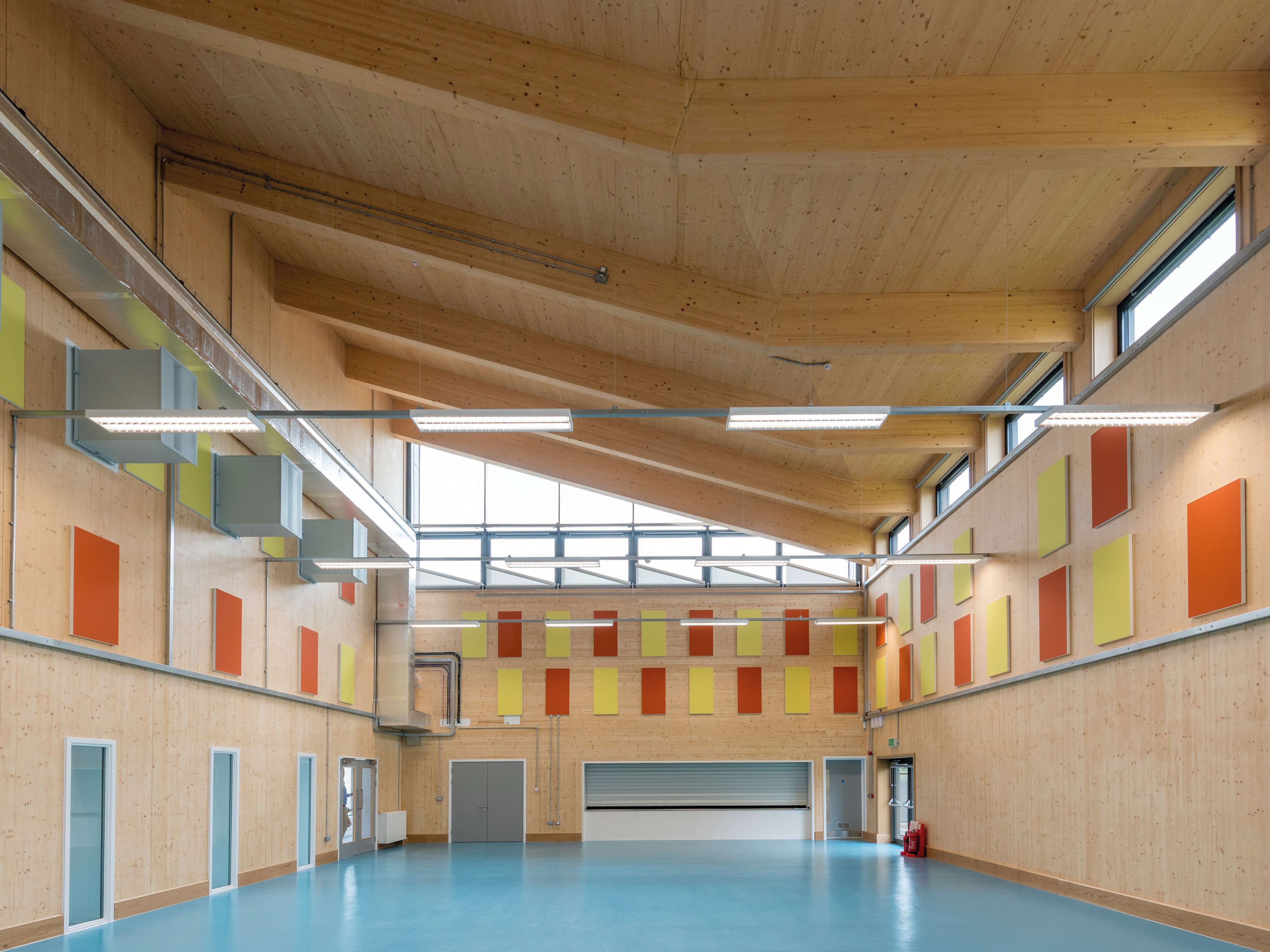
The education sector isn’t fully realising the carbon benefits of Passivhausprinciples, says Gary Alston, Design and Technical Director at ECD Architects, whoexplains what’s required to increase uptake of a building standard that can reduceenergy costs, cut carbon emissions and enhance teaching and learning environments
PASSIVHAUS is a set of voluntary The education sector is well poised for The Trust also reports there are 43 technical standards originally embedding Passivhaus principles. The educational schemes under construction devised in Germany and now being Department for Education (DfE) is or awaiting Passivhaus certification. To adopted globally. In the UK, the Passivhaus championing a Climate and Sustainability put these numbers in context, a House of Standard is utilised extensively throughout Strategy, which is striving for education Commons Committee Report (19th Nov All images: Thornhill School2023) highlighted that in January 2023 there were 21,600 state schools in England, accounting for 64,000 buildings. The small number of Passivhaus schools is also contextualised by the DfE’s School Rebuilding Programme: 518 projects are listed in the programme, with an impressive delivery rate of 50 projects per year. This level of progress suggests, conservatively, there should be many more than 43 Passivhaus education buildings in the pipeline. So, why aren’t there? The challenges facing Passivhaus areas follows. Passivhaus adoption is in its infancy in the education sector due to alack of awareness and limited collaboration during the inception of projects. Existing sustainability and energy rating systems in the UK, including the Building Research Establishment Environmental Assessment Method social housing. A key reason for this is,because it’s a design and specification process that delivers extremely energy efficient houses. This works for residents, who find it more affordable to heat their homes and who also enjoy better levels of indoor air quality and thermal comfort. It’s also advantageous for social housingl and lords, as it supports goals to address fuel poverty and lower carbon emissions towards achieving Net Zero Carbon These benefits are delivered through awhole-building approach based on clear, measured targets for a building’s energyperformance, airtightness and thermalcomfort. Practically, this can involvedesign and specification considerations that create an airtight building envelope, minimise heat loss through thermal bridges, optimise insulation and utilise heat recovery systems. buildings to be net zero. Support isprovided by the DfE to help schoolsimplement a Climate Action Plan thatmakes sustainability a manageable goalfor each individual school. Alongside this climate advisors and ambassadors are helping schools to access initiatives and schemes, such as electric vehicle charging points and using UK-grownt imber in construction. Excellent sustainability progress is being made through out the education sector, and the wide spread ambition enthusiasm and support to transition tonet zero, suggests that Passivhaus should be booming throughout education estates. However, it isn’t .According to The Passivhaus Trust inthe UK, there are 28 Passivhaus certified educational buildings in the UK, with these spanning schools, colleges, and universities.

(BREEAM) and Energy Performance Certificates (EPCs), can mean Passivhausis overlooked, contributing to low awareness of the standard.Requirements around BREEAM certification, whether that’s to secure planning permission or a Government stipulation for new education buildings, will often result in this rating system becoming the default choice. A similar sentiment exists arounds EPCs, with adegree of confusion between what Passivhaus actually is. It can be wrongly perceived as being purely a certification process for energy efficiency, like an EPC, when Passivhaus is so much more. As wellas being an energy performance standard, Passivhaus is also a comfortstandard, with certified buildingsproviding high standards of proven indoor air quality and thermal comfort. Driving awareness and up take of Passivhaus would benefit from Governmentsupport. The principles of the standardalign well with the DfE’s Climate and Sustainability Strategy and its policy forcreating green, sustainable educatione states. Passivhaus can help deliver these goals and the education sector’s transition to net zero. Mandating the standard fornew schools or adapting building funding, design and build criteria to embed Passivhaus principles could encourage adoption on a similar scale to BREEAM. Improving awareness and adoption of Passivhaus would also benefit from greater collaboration, from the very beginning of discussing and designing education buildings. Construction projects often involve many different parties, each with differing objectives,opportunities and challenges. Conversations and planning can easily become fragmented, causing a breakdown in knowledge sharing. There’ slesser prospect of exploring different options and determining exactly what’ spossible for a project. Collaboration helps to avoid this. The Passivhaus designed and certifiedT hornhill School is a good example offirst of its kind in Bedfordshire, began with discussions between key members of school staff, the local authority and ECD Architects. This helped to articulate a vision for what all parties wanted from a planned extension of the school, rather than procurement becoming prescriptive, based on existing experiences and assumed knowledge. Conversations about energy performance, thermal comfort, the layoutof buildings and movement of pupils, led to an agreement that the Passivhaus standard would become the new building ’senvironmental goal. The project saw Thornhill School expand from a one-form to a three-form entry through the addition of a new building. This is arranged around a central playground, overlooked by circulation spaces and a new access deck, which wraps the entire two-storey section of the building. Avaluable breakout space for smaller group learning has been created and connects teaching with the outside. The principles of circular economy were followed within the design, with materials (specifically cross-laminated timber) selected for their low embodied carbon and their possible future reuse andr ecyclability. School staff continued to be involved throughout the design process ,with fortnightly on-site project team meetings, accompanied by key design team members as required. A high quality, Passivhaus certified building was created for Thornhill School. This is exceeding the school’s sustainability targets and design aspirations, while post occupancy evaluation and feedback from teachers shows a positive impact on pupils’ learnings.Embracing Passivhaus at Thornhill School shows what’s possible for the wide reducation sector as it strives towards net zero, while also enhancing teaching and learning environments. Hopefully it’s aproject that encourages further awareness and uptake of these sustainable design and specification principles www.ecda.co.uk
